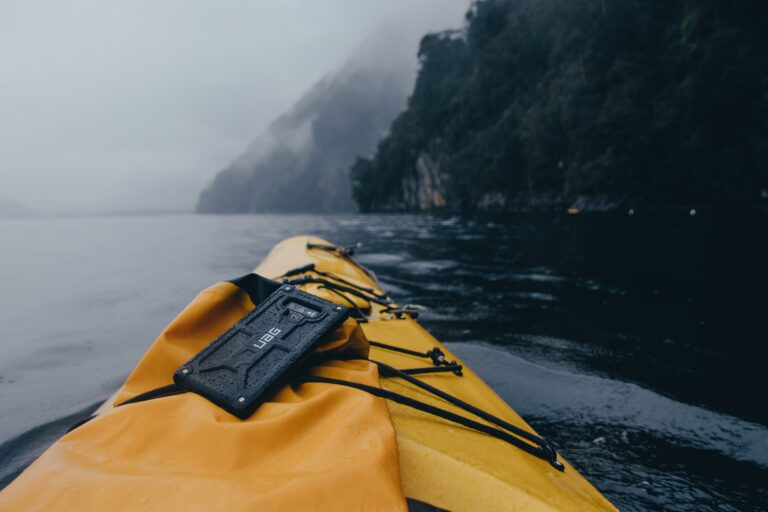It’s never too late to start kayaking! If you’ve been thinking about taking up kayaking but don’t know where to begin, this blog post is for you. Here are 10 tips that will help get your feet wet and make the process much easier:
Table of Contents
1. What is kayaking and how does it work?
Kayaking is a sport or recreational activity in which one paddles on the top of the water using kayak equipment. Kayaks are generally long, narrow, and made from fiberglass, plastic, or wood; but new materials such as aluminum can also be used to produce kayaks. The boat provides buoyancy and stability for the user while sitting at an angle near-horizontal with respect to the surface so that he/she has more control over his movements than if they were standing upright like when surfing.
2. Types of kayaks
There are many different types of kayaks, but they can generally be categorized into one of four main styles. These are as follows:
Recreational kayak: this is the best choice for beginners and those who want to paddle in flat water with no waves. They are generally wider than other types. They also have a flat bottom which makes them perfect for those with less experience because it’s easier to control where you go.
Whitewater kayak (or playboat): this style of boat is ideal for paddling on rapids or fast-moving rivers that have large drops and waves; it’s also used by surfers
Expedition kayak: these boats are usually quite long so that users can travel great distances without needing to stop too often. They’re a good choice when you don’t know exactly what kind of conditions you’ll face while out on the open ocean or big lakes
Fishing kayak: They are generally wide and stable, so they’re best for beginners who will be sitting in one place most of the time and will not be doing a lot of paddling
Sit on top kayak: these boats have an inflatable seat at the very front that you can straddle while sitting down. They’re popular among people who want to be able to explore shallow waters without making contact with them; beginners might find this style more comfortable because it’s easy to get back into if you end up tipping sideways or backward.
3. The different parts of a kayak
We know each kayak may have some similarities, but there are different qualities between kayaks.
The cockpit: it’s where you and your gear go in, basically like a roofless car or tank
Its shape: each kayak is shaped differently; some have flat ends that allow them to be flipped over easily (like the ones with small cockpits) while others may look more roundish which can help with tracking straight during paddling sessions
How wide they are: one of the main things beginners should consider when looking for their first kayak is whether it will fit through whatever entryways they need to use to get on open water (examples include doorways, boat ramps). A wider body means less ability to flip but easier access
The length: another important thing to consider is kayak’s length. This will affect how easy it is for you to control and maneuver
Width: there are wide kayaks as well, but these typically have high sides that can make entering or exiting difficult when they’re on dry land so this should be a consideration too
Weight capacity: some kayaks are designed with children in mind while others are made for adults only; if you plan on paddling with someone other than yourself then pay attention to this detail
Type of material used: all kayaks aren’t created equally, they can be made of plastic, fiberglass or aluminum; each kind has different benefits and drawbacks
4. Buying your first kayak
This is a difficult decision to make, but once you’ve narrowed down your choices from the tips above it should be easier. The most important thing is that kayak fits properly and comfortably. Once you have a kayak in hand, run your fingers along its length; this will help tell if it’s too short or long for you
Pay attention to where your feet are placed when sitting on the kayak – they should fall naturally under each foot brace. If not then consider trying another size (or model) of kayaks
Play around with positioning your hands on the paddle before buying so that you know how easy or difficult paddling might be for you as well as what positions would work best with which type of activity such
We also written a posts about how to choose the right kayak if you are a beginners.
5. Packing for your trip
You are excited to go kayaking! Now it is time for the planning – like what clothes and gear will you need?
In general, dress in layers that are comfortable and easy to remove. If possible wear a wetsuit or similar thermal protection under your clothing
Packing should be done intelligently so that we have everything ready when needed without wasting space, you want to move as lightly as possible.
If you have a lot of gear for kayaking, it may be helpful to pack your things in sets (paddles, life jacket and dry bag) so that they are easy to find when needed
Waterproof clothing is highly recommended because the water can get very cold even if the air temperature isn’t too bad
It also helps to bring sun protection such as sunscreen or sunglasses with UV protective properties. If kayaking at night then consider bringing lights like headlamps or hiking lamps which help us see where we’re going without killing our eyesight
Bring snacks and lots of water! It’s important not only to stay hydrated but also refuel after being out on the water all day long
6. How to Adjust Your Kayak
A well-adjusted kayak will be more stable and comfortable to paddle. Do your adjusting while the boat is sitting on dry land, and focus on three points of contact:
Stern: The kayak should feel stable when you lean back.
Forefoot: It’s important to make sure the kayak is sitting comfortably on your feet and heels, not just your toes or arches. Keep in mind that as a person pedals, their weight will shift forward onto their footpads (forefoot) so adjust accordingly.
Hip Belt: A hip belt can be adjusted up or down for comfort while paddling with different stroke techniques. If it feels right during one technique but uncomfortable during another then try using an alternate paddle technique until you find what works best for you!
7. How to Launch Your Kayak
This is commonly asked by beginner kayakers and is not a difficult task to complete. To launch your kayak from the shoreline:
– Face the kayak into the water so that you are standing at right angles to it
– Hold onto one end of the kayak while lifting with both hands until you can place one foot in front of it
Repeat this process for another side of the boat being careful not to let go as kayaks are heavy when wet! When ready lift up off ground using legs then release handgrip gradually support weight by bending knees keeping back straight.
Doing these steps will leave you just a few feet away from your destination!
TIP: Be sure to land upright (not sideways) however – if done incorrectly, there are chances you will tip over.
TIP: Always keep the kayak on your right side (if a left-handed paddler) as you move towards the shoreline, with a paddle across body and blade facing outwards!
TIP: Keep both hands on the paddle handle at all times to prevent loss of control when landing or taking off from land. The top hand should be closer to the shaft for better steering ability!
*Note – these tips are not comprehensive but will provide beginners an idea of where to start their journey into kayaking.*
8. How to Hold Your Kayak Paddle
It seems like a small thing, but kayak paddles are not held the same way as regular long-handled oars. The paddle should be gripped with one hand on top and one hand lower down the shaft for better control of your kayaking experience.
Some people find it helpful to think about steering their kayak when they grip the paddle this way so that there is always a clear focus point in case something unexpected happens during their trip! For those who want more guidance on how to hold them properly, you can view our “How To Paddle A Kayak 101″ blog post here: [link] https://www.rei.com/learn/expert-advice/getting-started-kayaking.html
9. The Basic Kayaking Strokes
It is good to know the basic kayaking strokes before you get started. There are two primary kayak strokes: forward and backward. When paddling in a straight line, use the Forward Stroke (also called “Away”) to move away from your starting point or destination. For example, if you want to paddle out of a cove into open water, this would be used when exiting the cove on your right-hand side.
To turn around at the end of a narrow channel, for instance, use Reverse Strokes (“Home”). This is also known as Paddling In Place–moving back towards where you came from while facing it–to keep yourself stationary against any current that might be pushing you downstream.
10. Using Rudders and Skegs
Rudders: If your boat has a rudder, it sits at the back of the boat, and you use your foot pedals to control whether the boat moves left or right. Push the foot peg on the right and your boat will turn right (and vice versa on the left).
Skegs: A skeg is a fixed-position fin that can be found on the bottom of a kayak. It helps to provide directional stability and is used when paddling in shallow water or getting through rapids.
Novices often misuse both skegs and rudders. A skeg is not used for turning but provides directional stability. A rudder, on the other hand, can be use to turn a kayak. It’s best to practice with both types of fins and boats when you’re starting out so that you know how they work in different waters before using them while paddling through rapids or into shallower water.

